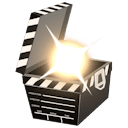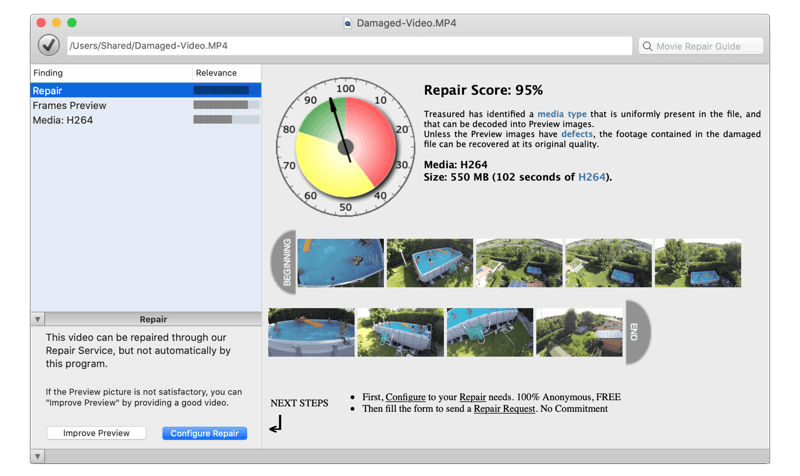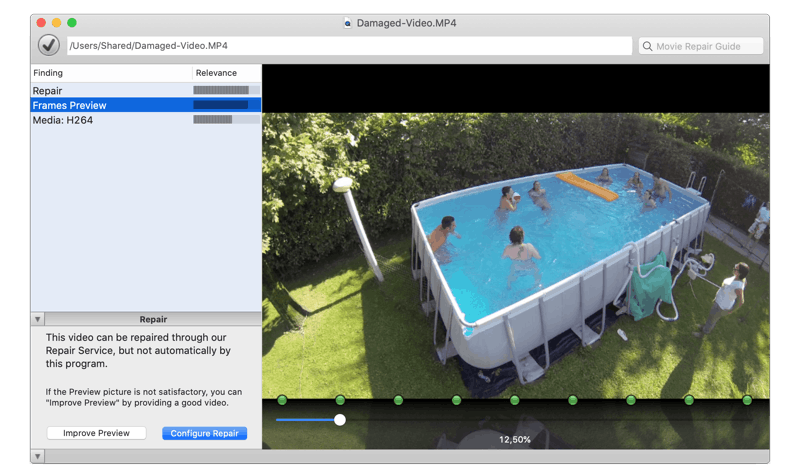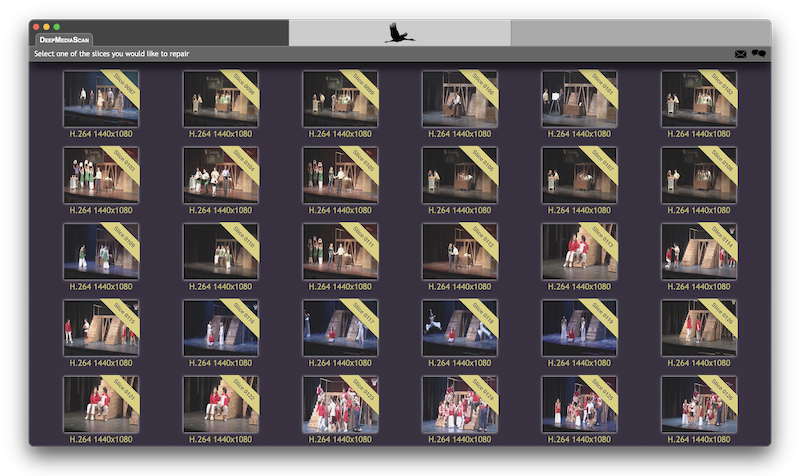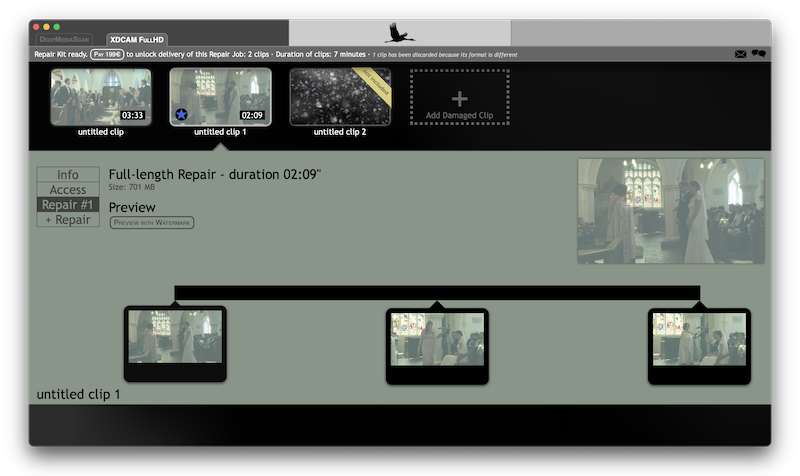Unsupported Browser
This page probably won't work great in Internet Explorer. We generally only support the recent versions of major browsers like Chrome, Firefox, Safari and Edge.
Don't panic! Our service gets you covered
If you have lost the videos that you had recorded on a memory card — after accidentally formatting the SD card, deleting the files, or if card is simply now unreadable — there are still ways to recover them.
At Aero Quartet, we have special tools and we do this every day for you.
Just relax and contact us.
The worst thing you can do at this point, is start trying random “miracle software” on the card. The less you use the card, the higher the chances to recover everything, so please quarantine the card and call us.
How does DeepMediaScan find the lost videos?
DeepMediaScan is the feature of Treasured application that scans a disk, SSD or card, to find all the video content still present on it.
The result is a Disk Map with thumbnails, where you can easily spot frames from the lost videos that you want to recover.
Take a walkthrough of DeepMediaScan to understand how it can help you.
Read what? All has been wiped!
Well... not really.
Wiping a card takes around 30 minutes, so if you have accidentally formatted or erased files, and it took just a few seconds, it is still recoverable.
Why is it so? Because at low-level, raw data of your files has not been erased.
Only the file records, that “book the space” of files, has been deleted.
But be careful! The space on the disk — we use disk as generic term for all kind of storage, SDXC card, hard disk drive, or SSD alike — is now available for use. This is why we ask you to quarantine the card and contact us immediately, because any activity on the disk can potentially overwrite — make disappear permanently — the lost videos.
Is the disk even readable?
A memory card, SSD or HDD is considered unreadable if, despite being connected to the computer, the disk icon doesn't show up in the Finder (or it is not detected by Windows).
To increase the chances of reading the card, try in a variety of conditions.
A memory card can be unreadable on your Mac with an external card reader, but can work on a Windows PC. Or it can work with a card reader but not with another. Or it can fail and then work when you insert it a few times.
If everything fails, the disk is not readable.
Unreadable disks cannot be examined by conventional tools. You will have to use a data recovery laboratory, to bring your disk back to a readable state. In the worst cases, it is not possible even using advanced white room techniques.
But if data can finally be read, ask your data recovery service to dump the entire content of the card into a disk image. The disk image is what we will then use as source, instead of your unreadable card, to find the lost videos.
What does “read the disk” mean?
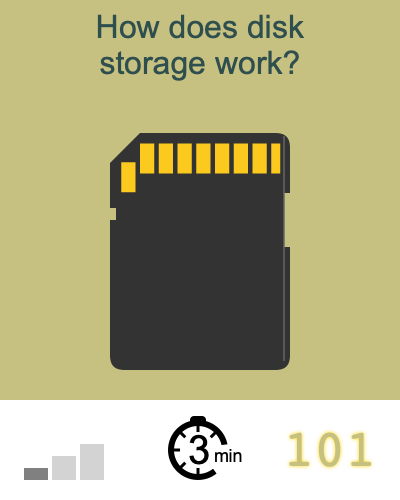
To recover files or whole disks, you need to read the disk at low-level.
Computer operating systems show you a graphical representation of files and folders. Finder or File Explorer in Windows, with icons on your Desktop.
You can also browse the files with the command line — Terminal in macOS, or MS-DOS command interpreter cmd in Windows.
But in case of a damaged disk, those two methods to access the files do no longer work.
The file system that kept tabs on your data, has imploded.
Data is still here, but we are on our own. We need to by-pass the operating system and read directly the raw data written on the physical device.
At this low level, the information is no longer organized in folder and files, but in fixed-length blocks or sectors, a bit like a huge mosaic made of identical tiles.
The data of a file is contained by one or several tiles, sometimes millions of them. In the best case, tiles corresponding to a file are contiguous. But in a fragmented disk, a file can be scattered in many disjointed tiles, making it very difficult to recompose it.
How to read a damaged disk?
DeepMediaScan tool in Treasured is the preferred method to recover lost videos from a formatted card.
Other disk reading methods can be useful if to recover other types of data — pictures, email, office documents and so on.
For video recovery, creating a disk image of your card is necessary if you are not on Mac, and also when the card shows signs of instability.
Some cards are in precarious state, they start “mounting” and “unmounting” without reason and they can eventually stop working at all. In such cases, doing a card dump and securing the data in a disk image is a priority.
Tools to generate a disk image
- PREFERRED: DiskImage.exe, our disk image utility for Windows.
- photoRec, a free, open source utility (Mac, Windows)
- dd (Mac) and dd for Windows command-line utilities
- Disk Utility — an application included in macOS
- HDD Raw Copy Tool
Try Treasured to find your lost videos!
Our service offers:
- FREE diagnostics and preview with Treasured
- FREE sample of repaired video
- Try before you buy with a FREE trial of your Repair Kit
- Enjoy FREE customer support by speaking directly with our trained experts
- Invaluable expertise, dedication and second to none customer service

Treasured
Video Repair — online
Mac, Windows, Linux
Why is Treasured performing better than recovery tools on lost videos?
Treasured is designed to recover videos, and only that. Data recovery tools try to recover anything — pictures, email, office documents — and are good at restoring small files, that has been written in one shot.
Recovering media, not files
Videos are not small files and are not written in one shot, for this reason when a data recovery tools applies the same technique as for a picture, it doesn't work. The recovered video file doesn't work.
Unlike data recovery services and tools that try to recover files, Treasured tries to recover media instead:
Container data is what data recover tools use to detect and recovery files. But what matters is not the container, but the content: audio and video media. Treasured is first and foremost a media detector.
DeepMediaScan, the tool that Treasured uses to map all media present on a card, is able to find lost footage, even when things get more complicated...
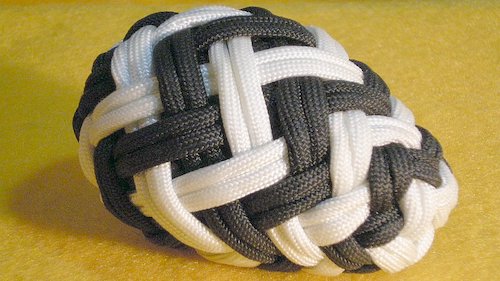
Interleaved Streams
Metadata and proxy files are often written during video capture. This poses a threat to recovery.
Why? How can the streams be separated?
Interleaved Streams
Recording becomes more sophisticated. More often that not, cameras capture not just main video signal, but also metadata files, external audio and proxy streams, that are written in separate files.
This is fine as long as files remain in good condition. But after any incident, when data is recovered at low-level, those data streams are deeply interleaved.
The challenge is to surgically separate them from the main video signal, otherwise any attempt to repair will fail.
We have the know-how to separate audio streams, video proxies and metadata from main video to achieve 100% clean repairs. Those jobs, however, require more expertise and work and have a higher service fee.
Fragmentation
If you don't do full recording - offloading cycles, always starting with an empty card, fragmentation will build up.
Why and what can be done about it?
Fragmentation
Fragmentation should not happen if card is used following a daily routine: Formatting, recording, offloading, and again...
But when this discipline is not strictly enforced, new videos become fragmented — Video data is not written in one region of the card, but is scattered over several spots.
In normal conditions, it's not an issue, but if card or video is erased, it makes the recovery much more complicated.
In DeepMediaScan map, you can spot the different regions corresponding to your missing footage, and get the video back with almost no loss.
Those jobs, however, require more expertise and work and have a higher service fee.
